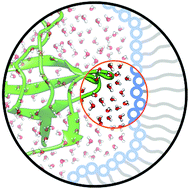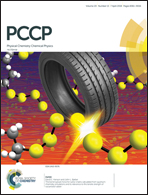Local chemistry of the surfactant's head groups determines protein stability in reverse micelles†
Abstract
When comparing protein folding in vitro and in vivo significant differences have been found. This has been attributed to crowding and confinement effects. Using a combination of GHz- and THz-dielectric relaxation spectroscopy and MD simulations, we studied hydration dynamics and reviewed protein stability data inside sodium bis(2-ethylhexyl)sulfosuccinate (AOT) and cetyltrimethylammonium bromide (CTAB) reverse micelles which are model systems for confinement. We find that water inside anionic AOT and cationic CTAB reverse micelles is characterized by a strong dielectric depolarization giving rise to a very low relative permittivity compared to an unconfined solution. Despite differences in the hydration dynamics of the surfactant's head groups, simulations using the two-phase thermodynamics method predict a similar reduction in water entropy for both reverse micelle systems compared to bulk water. When we compare the stability data of proteins in these reverse micelles we find that in contrast to our initial expectation, protein stability correlates rather with the local chemistry of the hydrated head groups than with the excluded volume effect or the low global permittivity.

- This article is part of the themed collections: 2018 PCCP HOT Articles and Celebrating Excellence in Research: 100 Women of Chemistry


 Please wait while we load your content...
Please wait while we load your content...